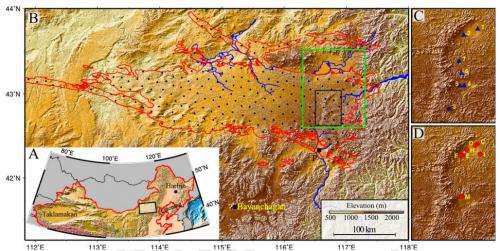January 6, 2015 report
Study indicates groundwater sapping led to desertification of parts of Inner Mongolia

(Phys.org)—A combined team of American and Chinese researchers has found evidence that suggests that parts of Inner Mongolia that were thought to have been desert for a million years, might have actually dried up just over four thousand years ago. In their paper published in Proceedings of the National Academy of Sciences, the team describes their research efforts, their findings and why what they have uncovered might lead to rethinking much of early Chinese history.
Most historians believe that the middle portion of the Yellow river was the cradle of Chinese civilization, despite evidence of a prior civilization living farther to the north in Inner Mongolia. Until now, details of that earlier civilization, known as the Hongshan Kingdom, (which was established approximately 6,500 years ago) was sparse, as most assumed it did not amount to much because it existed in a desert. But evidence uncovered by this new team of researchers suggests the area was not desert during that time period after all—it became that way thousands of years later, leading the people living there little choice but to emigrate south, quite possibly contributing to the rise of the Xia Dynasty, the first in China.
To come to these conclusions, the team conducted many field studies, including excavations of new artifacts in the region. They found examples of pottery and other stone artifacts that suggested a culture far more advanced than had been thought—one that was also bigger and dependant on hunting and fishing, which is not typically the case for desert dwellers. The team also studied the environmental landscape, and found that the sand dunes in the area were likely shaped by terrain that was formed by rivers and lakes. A closer look at quartz dug from the area showed it had been buried beneath the sand for just 12,000 years, a sign that up till that time, the area had been a lakeshore. Next, the team dug down and found sediments from a long dry lake which existed between 5,000 and 9,000 years ago—pollen in it revealed the presence of trees in the area.
All of the evidence combined suggested the area was quite fertile until approximately 4,200 years ago, when desertification set in. The team suggests the area became drier as water that once flowed into the area was diverted for some unknown reason to a river flowing east, forcing the people living there to flee south.
More information: Groundwater sapping as the cause of irreversible desertification of Hunshandake Sandy Lands, Inner Mongolia, northern China, Xiaoping Yang, PNAS, DOI: 10.1073/pnas.1418090112
Abstract
In the middle-to-late Holocene, Earth's monsoonal regions experienced catastrophic precipitation decreases that produced green to desert state shifts. Resulting hydrologic regime change negatively impacted water availability and Neolithic cultures. Whereas mid-Holocene drying is commonly attributed to slow insolation reduction and subsequent nonlinear vegetation–atmosphere feedbacks that produce threshold conditions, evidence of trigger events initiating state switching has remained elusive. Here we document a threshold event ca. 4,200 years ago in the Hunshandake Sandy Lands of Inner Mongolia, northern China, associated with groundwater capture by the Xilamulun River. This process initiated a sudden and irreversible region-wide hydrologic event that exacerbated the desertification of the Hunshandake, resulting in post-Humid Period mass migration of northern China's Neolithic cultures. The Hunshandake remains arid and is unlikely, even with massive rehabilitation efforts, to revert back to green conditions.
Journal information: Proceedings of the National Academy of Sciences
© 2015 Phys.org





















